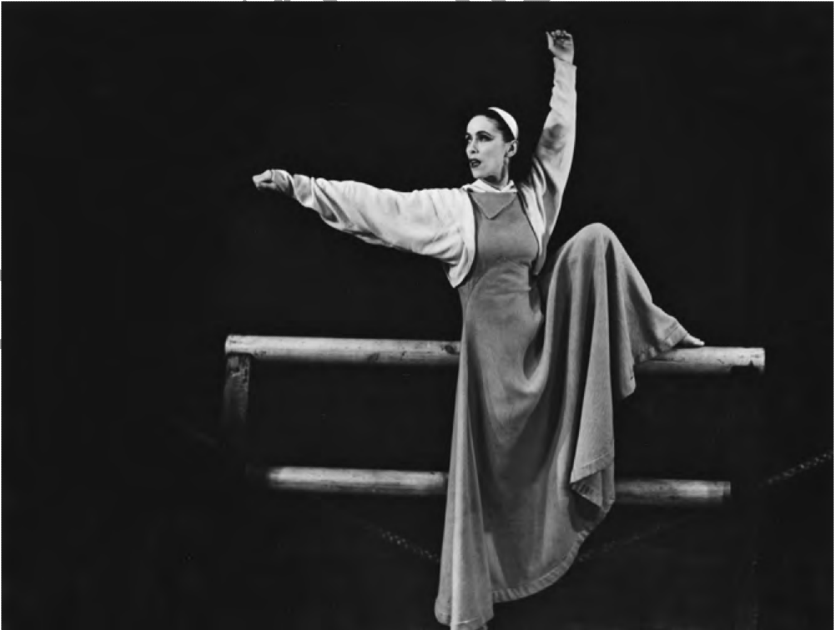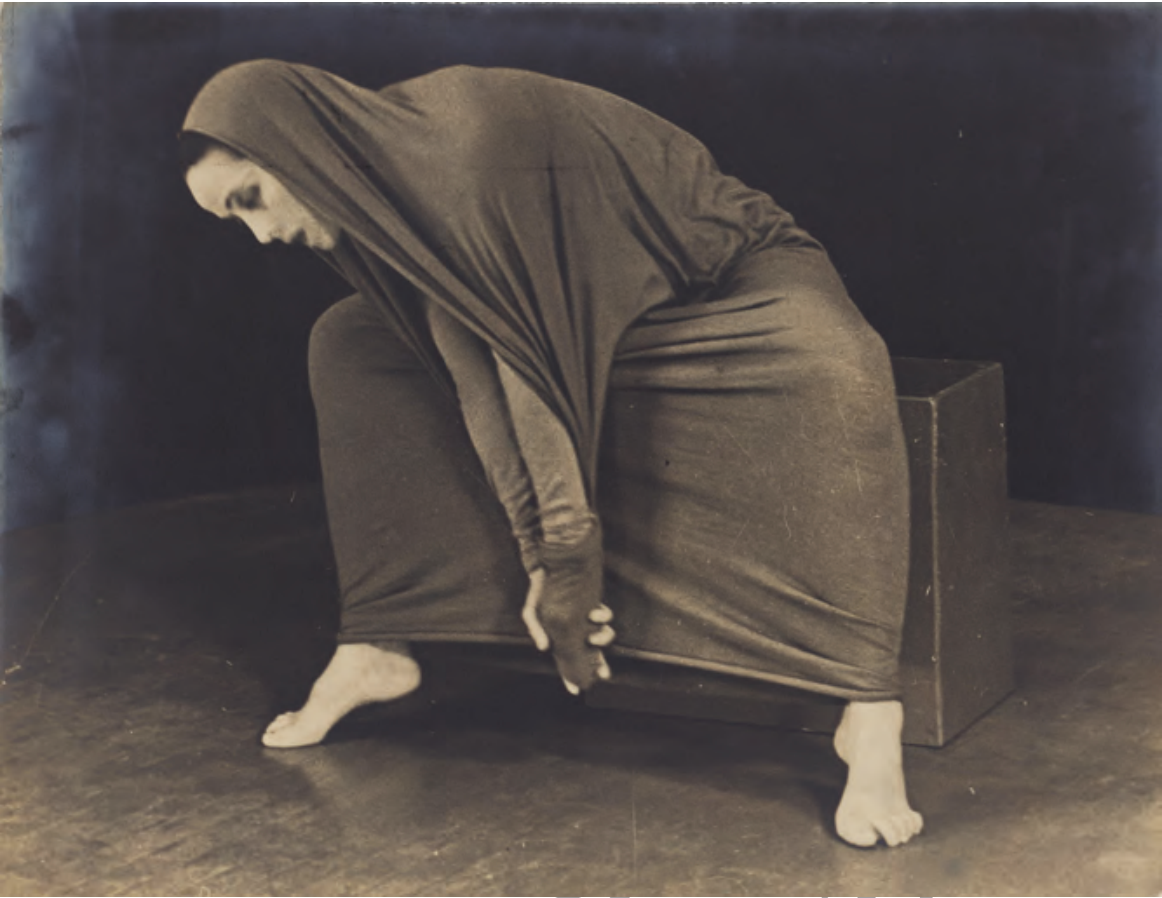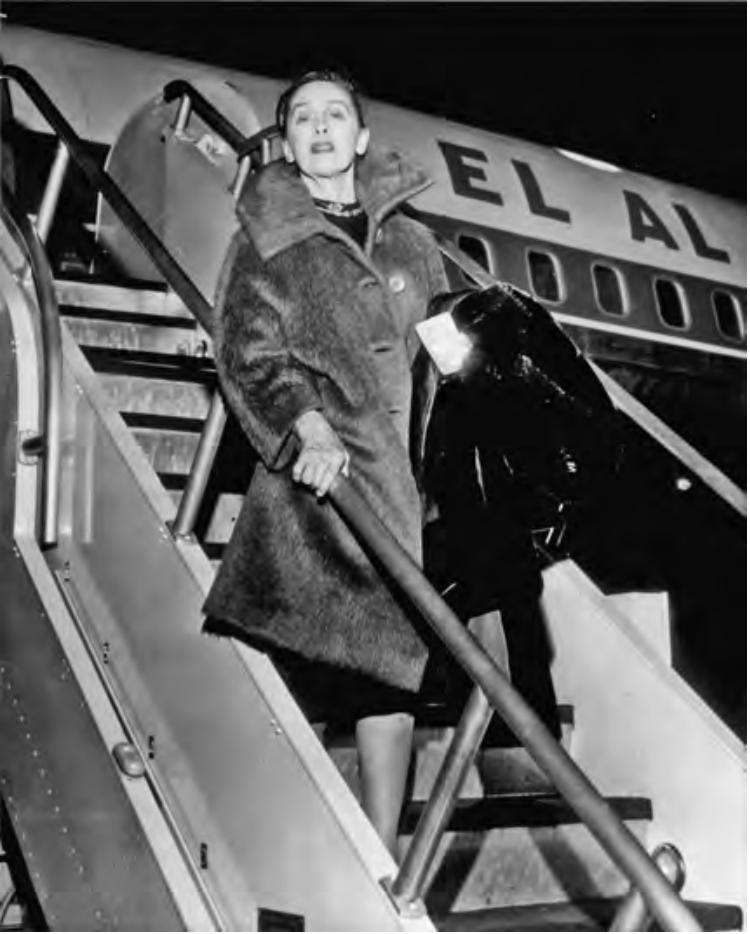
Martha Graham in Frontier, 1937, by Barbara Brooks Morgan, Courtesy of the Wight Gallery Collection 1938 – 1967, UCLA.
“I saw it go up and now I have seen it come down. It makes me feel triumphant to think that nothing lasts but the spirit of man and the union of man. People cross the border from East to West to shake the hands of those they have not seen before. In a way, they have become each other’s frontier.” – Martha Graham
Modern dancer Martha Graham may have been speaking about the Berlin Wall just before her death in 1991, and the concurrent end of the Cold War, but it was a sentiment that infused her work from the start. Born in 1894 in Allegheny, Pennsylvania, as a teenager she traveled through the West to California. She recalled the journey fondly, remembering the train tracks and cherished the indelible impression of the land unfolding in front of her.
Martha Graham, sometimes termed the “Picasso of modern dance”, was the first dancer to perform at the White House and travel abroad as a cultural ambassador. Representing every seated president from Dwight D. Eisenhower through Ronald Reagan, Graham performed politics in the global field for over thirty years during the Cold War, all the way through to the fall of the Berlin Wall, with a planned tour to the USSR which was never completed. One of her most important contributions to US cultural diplomacy efforts to forge human connections took place just after the Camp David Accords in 1979 under the Jimmy Carter administration. Graham performed works that celebrated the cultures of Israel, Egypt, and Americana as she toured Israel, Egypt, and Jordan. Her “Jimmy Carter Goodwill Tour” set the stage for the 1979 cultural agreement that encouraged exchange in tourism, science, archeology, and music — to name a few.
In the early twentieth-century, Graham began her dance training at the Denishawn School and quickly became integrated into the school and performing company. She moved on to create her own foundational dance technique, which remains one of the staples of modern dance training today. Born as a product of the global modernist impulse in the early twentieth-century, Graham’s technique used the pelvic contraction — weeping, laughing, breathing in ecstasy — as the source of all movement. By 1926, Graham had formed the Martha Graham Center of Contemporary Dance (See: Graham technique demonstration, documentary on the Graham company, and Martha Graham Dance Legacy Project).
Born as a product of the global modernist impulse in the early twentieth-century, Graham’s technique used the pelvic contraction — weeping, laughing, breathing in ecstasy — as the source of all movement.
Graham came to define modernism in dance through her work Lamentation in 1930, which premiered in New York. The work was the expression of grief; Graham stripped away the narrative — the who, the where, the why, the when. Through her technique, she strove to access fundamental human impulses that unified people in their expression. Yet she also strove to access an American impulse in dance, and again traveled West to visit pueblos; she returned to New York with the critically heralded Primitive Mysteries. These works of what were called “Americana” became manifest with Frontier, first performed in 1935, and the first modern dance to be performed at the White House under Franklin D. Roosevelt in 1937, with repeat performances fifty years later. It was followed by Appalachian Spring in 1944 (originally titled Ballet for Martha by Aaron Copland), which premiered at the Library of Congress and earned a Pulitzer Prize for the composer the following year. Established as one of the nation’s preeminent modernists, she choreographed works that expressed love and Oedipal angst through abstraction and ancient myths, from Diversion of Angels to Night Journey. It was this repertory that accessed the Cold War battle for “hearts” with emotions, “minds” with myth and the Western canon, and promoted the power of the frontier that made Graham the perfect ambassador for America.
In 1956, she travelled from Iran to Israel and was welcomed in both nations by embassies and the public. In 1979, Graham’s company of dancers, managers, stage staff, musicians, and the now eighty-five year old choreographer and ambassadress, crossed between Egypt and Israel by military plane as the sets and costumes were trucked across the desert: handed, piece by piece, from one man to another over the border as the trucks idled. Yet Graham’s desire to forge human connections with her dance began well before the Cold War. She was an expert for hire by the US State Department because of the artistic precedents she had set. Her works of lament, love, jealousy, heroinism, all described something each person could find in their own heart, soul, and lived life, and thus the individual described the universal. Her words about Diversion of Angels, a joyous work about love, are particularly poignant in our time of pandemic: “It was a rainy summer, and I thought no angels would ever come out. It was done only to bring out two things: the love of life, and the love of love.”
Yet Graham’s desire to forge human connections with her dance began well before the Cold War. She was an expert for hire by the US State Department because of the artistic precedents she had set.

Martha Graham in Lamentation, No. 20,1939, by Herta Moselsio, Music Division, Library of Congress.
1950 brought the first staging of the biblical Judith, the Jewish heroine who saves her people. Graham would reset and restage the solo work as a group work, musing about the heroine for decades as she visited Israel and explored the Old Testament. In 1956, after Graham’s first government tour’s official conclusion in Iran, the Baroness Bethsabée de Rothschild funded Graham’s continuation on to Israel. The American State Department, ambassador, and agencies all promoted her as a diplomat for exchange, and she was received by Israel’s leaders. Her performances were lauded. Between 1956 and 1978, she worked with Rothschild and the Israeli government to create Batsheva, the nation’s modern dance company. Graham visited often, even huddling with dancers for cover as bombs fell and rockets hit — staying on despite US embassy warnings, saying she would not leave friends. She sent her dancers to train Israelis in her technique and establish a school. Batsheva became the only company globally that was permitted to perform the Graham repertory, and the Israeli stars were the chosen few who could perform Graham’s coveted roles, from Jocasta to Joan, parts that Graham protected fiercely until her retirement in 1969.
In 1978, with the Camp David Accords, Jimmy Carter’s administration set out to broker not only geopolitical cooperation, but cultural exchange. Thus, Graham and her company set out for Israel, Egypt, and Amman, where Lebanese dancers joined them for the “Jimmy Carter Goodwill Tour.” It was the preamble to a little remembered cultural agreement signed between Israel and Egypt that forged cooperation in science, medicine, music, dance, archeology, people-to-people exchange through touring travel, and even stamps — so that messages could cross borders. Graham led the way; dancers, the intelligentsia, diplomats, stage-hands, airline crews, the military — they all came together, shook hands, and, for that moment, as a part of Graham’s dance, became one another’s frontier.
Graham led the way; dancers, the intelligentsia, diplomats, stage-hands, airline crews, the military — they all came together, shook hands, and, for that moment, as a part of Graham’s dance, became one another’s frontier.

Martha Graham arriving in Israel, 1956, Martha Graham Collection, Music Division, Library of Congress.
For further reading on this momentous exchange please see Dr. Phillips’ book, Martha Graham’s Cold War: The Dance of American Diplomacy. In addition, read Ambassador Sally Grooms Cowal’s blog on the cultural agreement during Phillips’ book talk at the National Museum of American Diplomacy, Washington, DC. Phillips’ livestreamed talks and conversations are updated weekly on her website, along with podcast interviews, an upcoming article on the practice of research and the hunt for the Jimmy Carter tour, and links to Facebook posts.
Victoria Phillips specializes in Cold War history, cultural diplomacy, and international relations. Her articles have appeared in such varied publications as the New York Times, American Communist History, Dance Chronicle, and Dance Research Journal. She has curated several exhibits on dance and politics in Europe and Washington, DC. Before her academic career, she was a dancer and then a portfolio manager on Wall Street. Her papers are held at the Library of Congress as the Victoria Phillips Collection.